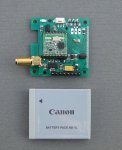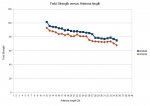I eventually had a chance to implement and test FSK RTTY from the RFM22 and the reception of it on a number of radios, including the cheap (£6) DVB TV Dongles.
The baseline is the RFM22 data packets (100mW) where the LOS range has been tested at 40kM, with 1/4 wave antennas.
The PICAXE satellite ($50SAT) has several different modes of transmitting, a slow Morse beacon, fast 120WPW Morse data, recently added AFSK RTTY and FSK RTTY plus of course the RFM22 data packets themselves.
I programmed a PICAXE $50SAT PCB to transmit a message with each of the modes. Then repeat the modes in a cycle with power reducing from 20dBm to 1dBm in 8 steps. The transmitter was put on a hillside outside of Cardiff at a distance of approx 4kM from my shed. The message being sent was the "QuickBrownFoxJumps". PC decode software was FLDIGI.
The mast with the receiving antenna was adjusted in height so that the RFM22 data packets were received only at 20dBm, power level 7 and were not received at power level 6, 17dBm.
The radios I had to test were from very cheap, £6, to not cheap;
Yaesu FT817 transceiver, £550
Yaesu FT60 HT transceiver, £150
UV100\VX3R HT Transceiver, £25
Funcube Dongle Pro +, SDR# PC Software, £150
DVB RTL2832 TV USB Dongle, SDR# PC Software, £6
$50SAT Ground station PCB, £20
These receivers were tested from the comfort of my shed to see at what power level the reception failed. The FT817 and Funcube Dongle received the FSK RTTY reliably at minimum power from the RFM22, 1dBm, so I went back up the hill and fitted a 20dB inline attenuator to the remote transmitter and the tests repeated. By the very nature of the testing the results are approximate and only intended as a guide.
Summary of the results are in the attached spreadsheet, where I have indicated in dB terms how much better that various modes and radios are when compared to the RFM22 data packet transmission and reception.
The FSK RTTY kept working when the transmit power was some 26dB lower than the RFM22 packets. At that power level, the slow Morse beacon was barely audible, listen to the enclosed MP3 file, the Morse being sent was just 'A' plus the digit of the power level number.
Whilst the FSK RTTY will provide for far longer range than the RFM22 data packets, it is relatively power hungry, approx 6 seconds at 100ma to transmit 20 bytes of data. Without a tracking antenna setup you also need to contend with large changes in the audio tones due to the Doppler shift changing. This should be manageable at the beginning and end of a satellite pass as the Doppler shift is relatively constant.
The cheap DVB USB dongle (£6) was a credible performer, but needs a low noise amplifier for long distance work.
By far the easiest receivers to use were the software defined radios. The SDR# software displays the RF spectrum around your chosen centre frequency and you will often see the satellite transmissions (SWISSCUBE and ITUPSAT1 for instance) before you can hear them, making dealing with Doppler fairly easy. When you see the transmission you just click the mouse onto the signal to tune the radio.
The FSK RTTY should be a good mode for balloon tracking, where a LOS range of 500 - 1000km ought to be possible.
No firm news on the satellite launch yet, the PICAXE satellite is due to go up as part of MRFOD payload that Unisat 5 is carrying;
http://space.skyrocket.de/doc_sdat/unisat-5.htm
Unisat 5 is on the same launch as the Funcube satellite, see the TBD section at the bottom;
http://space.skyrocket.de/doc_chr/lau2013.htm

